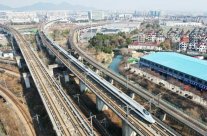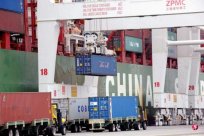
According to the data released by the Singapore Food Bureau on May 20, Singapore's self -yield last year increased by about 12 % compared with the previous year, and the self -yield of vegetables and seafood slipped by about 15 % and 7 %, respectively.The overall local food productivity has failed to meet about 10 % of the nutritional needs of Chinese people for three consecutive years.30 % of nutritional needs are still a lot of distance.
Dr. Xu Baozheng, Minister of Government, Senior Government of the Ministry of Environment and the Ministry of Personnel, said earlier this month. In an interview with Lianhe Zaobao earlier this month, the development plan of the Linkong Port Agricultural Land is expected to take shape at the end of this year or early next year. The local agricultural industry is in the backward crown.The era of disease and epidemic is gradually operating normally.The government predicts that in the next few years, it will decide whether to review the above goals.Agricultural production is inseparable from the good use of land, especially in Singapore, which is scarce and precious in land resources.Therefore, this factor plays a key role in implementing the "30 · 30 Vision".
If the progress of the past five years, the vision is to be achieved according to the plan, the official has no grasp of it, and the review may be necessary.The development of the next few years may be the key to success or failure.The implementation of this key to the implementation of the agricultural land development plan of Lindu Port, the relevant plan is expected to take shape at the end of this year or early next year.In addition, the local agricultural industry has gradually restored its vitality in the era of post -crown disease.Xu Baozheng said, "Can we perfectly realize the 30 · 30 vision? Maybe not ... but we should not pay too much attention to the number, because the epidemic impact, the delay of construction engineering, and the rise in price of agriculture are understandable.Don't be too anxious, high -quality farms still exist. "
In any case, the practice of these years shows that in order to increase the local food productivity challenges, there are many subjective and objective factors that must be overcome, and it cannot be resolved in a short time.Taking the breeding of golden bass as an example, last year, the aquaculture company Barramundi Group decided to suspend the breeding and transfer the business to Brunei because of the golden bass farm in the southern waters in the southern waters.The Food Bureau originally planned to set up fish farming farms near the three southern islands, but because they were worried that they might affect a variety of coral reefs and endangered species, the bidding projects of two fish farming fields were postponed, but the deadline was unreasonable.The recent news is that the Food Bureau will improve the infrastructure of maritime fishing grounds at this area.This also reflects the dilemma faced by Singapore with limited survival space.
Another example is indoor vegetable planting.Vertivegies of Vegetable Factory originally planned to build the largest local indoor farm and produce six metric -ton vegetables each year. However, this two hectares of projects were blown two years ago because they encountered problems with Chinese investors.Last year's vegetable output accounted for 3.2 % of total consumption, which was 3.9 % lower than the previous year.The percentage of seafood production accounted for total consumption from 7.6 % in the previous year to 7.3 % last year.Only egg outputs are exclusively, accounting for 28.9 % in the previous year to 31.9 % last year.Local vegetables and seafood products do not get enough support for consumers. I believe it is the lack of competitiveness in prices, showing a highly restricted role in land and human costs.
But no matter what difficulty, frustration and challenges encounter, the efforts to develop local agriculture must persist. This is a work that ensures that Singapore's food safety cannot be done, and it is the need for the country to survive.We must try to consolidate the foundation of agricultural and make good use of technology to improve productivity.In this regard, due to the relatively high cost of investment in manufacturers, officials may consider how to better ensure the stability of the use of agricultural land in order to attract high -tech producers for long -term investment.From the high thinking of food security equals national security, the planning and use of land cannot be based on economic benefits.
However, in order to ensure the safety of Singapore's food supply chain, it is still necessary to go hand in hand in dual tracks. In addition to the development of local agriculture, it must continue to expand and strengthen the toughness of the international supply chain.In this regard, it is important to use Singapore as the position of international transportation and transportation hubs to strengthen the connectivity of sea, land and air and air between Singapore and around the world.Only in this way can we ensure that the diversified food chain will not be blocked as the crown disease epidemic.
The Food Bureau adopts such a dual insurance strategy. Anyway, so far 90 % of our food supply is still relying on input.Last year, the Food Bureau approved Spain to supply mutton for Singapore, approved Indonesia's supply of eggs and living chickens, and also approved Turkey's supply of eggs.There are 187 countries and regions of imported sources, which are increased from 183 previous year, and 41 of which are allowed to export livestock, meat and eggs to the local area.In addition to ensuring the diversity of the source, near -shore outsourcing (that is, the development of agricultural development of the rich land resources in neighboring countries) is also a source of continuous development.




